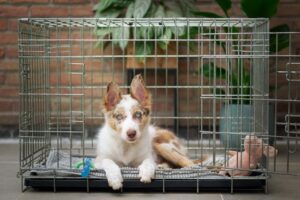Understanding Separation Anxiety in Dogs: Signs, Causes, and Solutions
This article provides an in-depth understanding of separation anxiety in dogs, including its causes, prevention and treatment methods, behavioral modification techniques, and the potential role of medical interventions in helping dogs cope with this condition.
Understanding Separation Anxiety in Dogs
Separation anxiety in dogs can have a significant impact on their well-being, affecting their mental and emotional state when left alone. Dogs with separation anxiety may become overly attached or dependent on their family members, making it challenging for them to cope with being alone. This can lead to various distress behaviors, such as vocalization, destruction of household items, or house soiling, as they exhibit signs of anxiety and stress in response to being separated from their owners. These behaviors can be disruptive and damaging, causing distress for the dog and their owners alike.
In addition to the more commonly recognized signs of separation anxiety, there are also less common indicators that warrant attention. For instance, some dogs may exhibit trembling, vomiting, or a lack of interest in eating when left alone, which can be indicative of their anxiety and discomfort during periods of separation. Understanding these less common signs is crucial for pet owners in identifying and addressing separation-related behaviors in their dogs, as it allows for a more comprehensive approach to managing and mitigating the effects of separation anxiety on their pets’ well-being.
Causes of Separation Anxiety
Separation anxiety in dogs can be triggered by a variety of factors, leading to distressing behaviors when left alone. Some dogs may develop separation anxiety due to a lack of daily exercise, which can result in pent-up energy and frustration when they are left alone for extended periods. For example, a high-energy dog breed like a Border Collie may become anxious and exhibit destructive behaviors if they do not have an outlet for their energy through regular exercise and mental stimulation.
In addition to exercise-related triggers, traumatic separation experiences can also contribute to separation anxiety in dogs. For instance, a dog that has been through a distressing event such as being left alone for an extended period without any preparation or support may develop separation anxiety as a result of the negative experience. This can lead to a heightened sense of fear and distress when faced with similar situations in the future, causing the dog to exhibit behaviors like excessive vocalization, destructive acts, and attempts to escape confinement.
Furthermore, significant life changes such as the loss of an important person or changes in the household environment can also be potential triggers for separation anxiety in dogs. For example, a dog that has recently experienced the loss of a family member or a change in residence may struggle to cope with the resulting emotional stress and uncertainty, leading to the development of separation anxiety. These changes can disrupt the dog’s sense of security and stability, making them more prone to exhibiting distress behaviors when left alone.
 Prevention and Treatment of Separation Anxiety
Prevention and Treatment of Separation Anxiety
Preventing separation anxiety in puppies is essential for their well-being. Proper socialization and training play a crucial role in helping puppies adjust to being alone without experiencing distress. Ensuring that puppies have scheduled alone time to amuse themselves with toys can prevent them from becoming overly attached or dependent on family members, thus reducing the likelihood of separation anxiety. For example, gradually introducing short periods of alone time and gradually increasing the duration can help puppies become accustomed to being on their own, minimizing the potential for separation anxiety to develop.
Moreover, techniques such as counterconditioning and desensitization are effective methods for addressing separation anxiety in dogs. By associating being alone with something the dog loves, such as a food-stuffed toy, counterconditioning can help change the dog’s negative emotional response to being left alone. Additionally, desensitization involves gradually exposing the dog to situations that provoke anxiety, starting with short separations and increasing the duration over time. This gradual approach can help the dog learn to enjoy or tolerate being alone, contributing to the reduction of separation anxiety symptoms.
Recognizing the importance of prevention and early treatment is crucial for managing separation anxiety in dogs. By proactively addressing potential triggers and providing the necessary training and support, dog owners can significantly reduce the likelihood of separation anxiety developing or mitigate its impact if it occurs. This proactive approach can lead to better overall well-being for dogs and a more harmonious relationship between pets and their owners.
Behavioral Modification and Training for Dogs with Separation Anxiety
Retraining is an essential aspect of addressing separation anxiety in dogs, as it helps them gain independence and become more accustomed to spending time away from their owners. This process involves implementing specific techniques to modify the dog’s behavior and response to being alone. For instance, counterconditioning is a common method used to associate being alone with positive experiences, such as receiving a special treat or engaging with a favorite toy. By reinforcing positive associations with alone time, dogs can learn to feel more at ease when separated from their owners. Our dog trainers at Off Leash K9 Training in Stamford are here to assist you and your pet on this adventure.
In addition to retraining, teaching independence is crucial for dogs with separation anxiety. This may involve gradually increasing the duration of time the dog spends alone, starting with short intervals and slowly extending the length as the dog becomes more comfortable. Additionally, providing physical and mental stimulation through activities like interactive games, walks, and puzzle toys can help alleviate anxiety and keep the dog occupied during periods of separation. Moreover, creating a predictable routine before departure, such as a specific sequence of actions or cues, can help reduce the stress and uncertainty experienced by the dog when their owner leaves. These measures aim to create a more secure and comfortable environment for the dog, ultimately contributing to the reduction of separation anxiety symptoms.
Medical Interventions and Support for Dogs with Separation Anxiety
When it comes to addressing separation anxiety in dogs, medical interventions can play a significant role in reducing underlying anxiety and supporting the well-being of our furry friends. For instance, in cases of severe separation anxiety, drug therapy prescribed by a veterinarian can help alleviate the distress experienced by the dog during periods of separation. These medications may include anti-anxiety drugs or other pharmaceutical treatments that can aid in calming the dog’s nerves and reducing their stress levels.
Moreover, natural supplements, such as calming pheromone diffusers or chews, can also be considered as part of the supportive care for dogs with separation anxiety. These supplements are designed to help soothe the dog’s nerves and create a more relaxed environment in the absence of their owners. However, it’s important to emphasize that any medical intervention, whether pharmaceutical or natural, should always be used under the guidance and supervision of a qualified veterinarian. Consulting a veterinarian ensures that the chosen interventions are safe and appropriate for the dog’s specific needs, taking into account factors such as their health condition, age, and overall well-being.
In conclusion, while medical interventions and support can be valuable tools in managing separation anxiety in dogs, their usage should always be approached with the guidance of a veterinary professional to ensure the well-being and safety of our beloved canine companions.
 Conclusion
Conclusion
Understanding separation anxiety in dogs is crucial for their overall well-being. Puppies and adult dogs can exhibit a wide range of distress behaviors, such as vocalization, destruction, and house soiling, when suffering from separation anxiety. Additionally, less common signs of separation-related behaviors, like trembling, vomiting, and loss of appetite when left alone, can also indicate the presence of separation anxiety. These symptoms can have a significant impact on the mental and emotional health of dogs, emphasizing the need for proactive measures to address this issue.
To effectively address separation anxiety in dogs, it’s important to take a comprehensive approach that includes prevention, training, and, when required, medical support. Prevention strategies, such as proper socialization, training, and scheduled alone time for amusement, can significantly reduce the likelihood of separation anxiety developing in puppies. In addition to this, understanding the potential triggers, such as loss of an important person or changes in schedule, residence, or household membership, can help pet owners create a supportive environment for their dogs. Furthermore, a combination of behavioral modification techniques, including counterconditioning, desensitization, and retraining, along with medical interventions like drug therapy and natural supplements, can be employed to alleviate separation anxiety and improve the overall well-being of dogs [1]. This comprehensive approach not only addresses the symptoms but also delves into the root causes of separation anxiety, thereby promoting a healthier and happier life for dogs.

